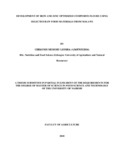| dc.description.abstract | Child malnutrition is among the major problems in low income countries such as Malawi. The most common forms of malnutrition are protein-energy malnutrition, vitamin A deficiency, zinc deficiency and iron deficiency anemia and are mostly caused by dependence on monotonous cereal based weaning foods which do not provide enough nutrients for rapid growth and development. This study aimed at improving the contents and bioavailability of iron and zinc of the cereal based complementary porridge currently used in Malawi.
Raw materials used in the formulation were pigeon peas (Cajanus cajan), finger millet, pumpkins (fresh and seeds) and maize. These ingredients underwent simple inexpensive household level food processing technologies such soaking, roasting and germination. The control complementary flour was prepared from 100% raw maize flour. Four complementary porridge flours named cereal-pulse-vegetable flours (CPV1, CPV2, CPV3, and CPV4) were developed from blends of the selected ingredient in varying amounts. Sensory evaluation of the developed products was done using 10 untrained panelist to assess the attributes of taste, smell, mouthfeel, colour and general acceptance. The most preferred flour was evaluated for keep quality using accelerated shelf life testing in three different storage containers namely gunny bag, kraft paper and plastic container. Microbial analysis (coliforms and yeast and molds) and chemical parameters (moisture and peroxide value) were monitored every 24 hours. The effect of processing on iron and zinc bioavailability was also analyzed using in vitro enzymatic digestion on CPV1, which was a blend made of unprocessed foods and CPV2 that was developed from processed foods.
The developed flours provided significantly (P≤ 0.05) higher amounts of Iron (17.3-21.2 mg/100g), zinc (4.3-5.2 mg/100g), protein (11.9-14.1 g/100g) and energy (387.6-398.6 Kcal) as
xvi
compared to the control. All the four flour blends developed met over 80% recommended nutrient intakes for energy, protein, iron and zinc. The best flour blend was CPV3 because it provided the highest amount of iron, zinc and protein. Sensory analysis of the porridges formulated flours conducted by untrained caregivers (panelist) showed that CPV2 (70 g finger millet + 15 g roasted pigeon peas + 8 g pumpkins + 7 g soaked maize) was the most preferred composite flour. The shelf evaluation of CPV2 was longest in kraft paper and plastic container which was significantly safe for consumption up to four months. In vitro enzymatic digestions for CPV1 and CPV2 showed that CPV2 had significantly high amount of bioaccessible iron and zinc (7.14 and 1.8 g respectively) against CPV1 which had 2.8 and 1.1 g for iron and zinc respectively. The study recommends germination as the best processing method for cereals because it significantly increased the amount of nutrients of interest. It also recommends the use of roasted legumes for they impart desirable sensory attributes in complementary foods. The use of all these simple food processing methods should be promoted because they have proved to increase the iron and zinc bioavailability. | en_US |



